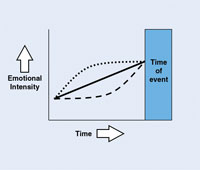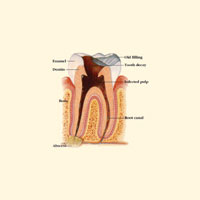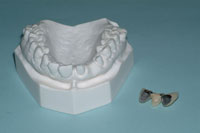Practicing dentistry in the 21st century is more demanding and stressful than ever before. We are incorporating more and more technology in our treatment rooms, and the general environment is constantly changing. Our patients expect our practices to provide stellar customer service and to be on the cutting edge. A lot of information is available, and not all of it will work in every practice or in every situation. Good systems are vital if you are going to gain control of your practice, have trained staff, and shut the back door to the office. They will help you move away from having to micromanage your staff and move toward enjoying your work a lot more.
Certain vital activities should take place to keep the treatment room busy. If properly executed, they can revive floundering practices and bring others to a whole new level.
In Part 1 of this article I shared the following 5 points: (1) keep score, (2) appoint the right person to engineer your daily treatment schedule, (3) track the percentage of chair time utilized, (4) have a daily production target for all providers and have an overall office target as well, and (5) do not send pretreatment estimates.
Now that you have started implementing the material and are beginning to unlock the potential of your practice, you should be seeing some improvement. In this article I will share 5 more actions to enhance your practice further.
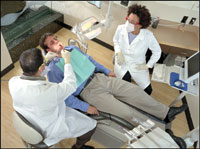 |
MEASURE YOUR DENTAL ASSISTANT’S EFFICIENCY
Doctors have been asking us for years how we measure the efficiency and effectiveness of dental assistants. Practices have been looking for ways to track their performance. Our solution is to have dental assistants fill out the Dental Assistant’s Efficiency Chart on a daily basis. They rate themselves in various categories based on the time the patient spent in the chair. The efficiency chart encourages the assistant to be aware of several key responsibilities, as seen in the Chart.
ENSURE A STEADY FLOW OF PATIENTS WITH A WRITTEN PROTOCOL FOR CONTINUING CARE
Don’t assume your continuing care or patient recall system is consistent or being implemented properly. My suggested goal is to have 80% of hygiene patients returning for continuing care visits; I usually see that this percentage is much lower.
It’s common for me not to find any exact protocol for recalling hygiene patients back to the practice. I also see practices where this important action is either not being done consistently or not being done at all. When I start looking at unsuccessful hygiene programs, I find that outgoing calls aren’t being made to patients, cards aren’t always mailed, and the hygiene department has open time on the schedule.
|
Chart. The Dental Assistant’s Efficiency Chart.
(Classic Practice Resources has made The Dental Assistant’s Efficiency Chart available to download from its Web site, located at ClassicPractice.com.) |
The doctors often complain that the hygiene department is seeing fewer patients than 6 months before, even with new-patient numbers higher than ever. This tells me that patients are arriving but are not staying in the practice. The back door is wide open, and the practice is doing something that keeps the patients from returning. Many times it is because the recall system is weak and patients are falling through the cracks. I also see offices never attempt to communicate with patients to get them back. In rare instances where they tried, their verbal skills were so poor that it was a wasted attempt.
Upon interviewing staff I hear varied responses about how the office handles continuing care and follow-up visits. Inconsistencies in the recall system can be costly to your practice. One way to cut down on the number of patients falling through the cracks is to make sure all patients leave the office with their next appointment scheduled.
I have often found recall cards not being mailed on a set schedule, and when they are, the message is not always clear. The cards/letters should be conservative in order to reflect the seriousness of good dental health. Dental professionals have a responsibility to educate the public, and staff members need the proper training to make this happen. Many staff members do not know the difference between a recall card that is sent to patients without an appointment and an appointment card that is sent to patients who have a prescheduled appointment. These are very different cards and should be sent at different times.
Begin solving this problem by writing the exact procedures for recalling patients. I suggest to my clients that they mail recall cards/letters on the 15th of each month to patients who are not scheduled and due the following month. Appointment cards should be sent each Wednesday for patients with a prescheduled appointment 3 weeks away. At the end of each month don’t forget about all of the patients who were due to come in but did not. This is where I see practices losing ground. They concentrate on patients due during the current month and leave the overdue patients behind, counting on “good luck” to bring the patient back to the practice. It is every staff member’s responsibility to keep patients active in the practice.
KEEP YOUR CHAIRS FULL BY HAVING A “LIVE” PERSON ANSWER YOUR TELEPHONE
I am appalled when I call dental practices during regular office hours and hear a voicemail system. The public expects dental practices to answer the telephone! Getting callers lost in a voicemail system is a sure way to lower your new-patient numbers. As a new patient is searching for a dentist, he or she is more likely to make an appointment if a “live” person answers (Figure 1). This is what I consider to be a huge barrier to practice success. If the patient calls and no one answers, chances are he or she will go to the next name in the telephone book.
Another way to upset your patient is to have a voicemail system answer the phone and tell the caller the office staff is helping another patient. This procedure is guaranteed to lose patients for you. If you doubt my advice, then get caller ID on your main line and check all the calls you are missing. Most patients do not want to leave a message on voicemail. I’ve personally experienced staff members visiting with each other and letting voicemail pick up while they finish their personal conversation. The sad part is the doctor’s schedule was only 50% full for that day and even less the next day. This is a sure way to run off existing patients, to prevent new patients from reaching you, upset current patients, and keep your income down. New and existing patients are vital to the growth of your practice. Remove the barriers and make it easy for them to contact you. Your telephone is the gateway to your office and should be top priority.
INCREASE HYGIENE PRODUCTION WITH AN EFFECTIVE REACTIVATION PROGRAM
Many of my new clients are surprised to learn that they have another practice in their files. They are “hungry” for new patients, when in fact they are “starving in a grocery store.” It is not uncommon for me to find tens of thousands of dollars in diagnosed treatment right there in the practice. Many existing patients have no future recall date and have just fallen through the cracks, with no one attempting to get them back.
Every practice has patients who return every 6 months, without fail. These patients are taking great care of their teeth and need very little treatment. They are not the ones needing special attention, and they are not the ones who will put production in your chair. I recommend performing a reactivation program once a year.
The steps for the reactivation program are listed below for both paper-based and paperless practices.
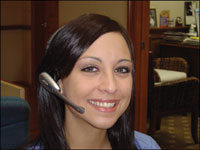 |
 |
| Figure 1. As a new patient is searching for a dentist, he or she is more likely to make an appointment if a “live” person answers the telephone. | Figure 2. Example of a Reactivation Card to send to patients who have not visited the practice for 6 months or more. |
Reactivation Program With Paper-Based Records
- Compare the incomplete treatment noted in the physical record to what has been entered in the computer. Update the computer, if necessary.
- Enter a current recall date in the computer if there is not one.
- Verify the patient’s contact information and ensure the computer has the most up-to-date information.
- Confirm that medical history, including allergies, has been entered in the computer.
- Generate a report of patients who have not visited the practice for 6 months or more; go back at least 3 years. These are patients who will need to see the hygienist.
Send a card to each patient on the report, inviting him or her back to the practice (Figure 2).
The same type of card, with the same message, will be sent to each patient 3 times, unless he or she calls to schedule an appointment.
Reactivation Program in a Paperless Practice
(1) Generate and print a report showing all patients who have not visited the practice for 6 months or more, going back at least 3 years. These are patients who will need to see the hygienist.
(2) Send a card to each patient on the report, inviting him or her back to the practice.
(3) The same type of card, with the same message, will be sent to each patient 3 times, unless he or she calls to schedule an appointment (Figure 2).
Offices are reporting that anywhere from 12% to 19% of patients are calling in to schedule an appointment as a result of this project. The success seems to be sending the same card 3 times in a row to patients who have been putting off treatment. A mass mailing is very helpful and should be done with each reactivation program. It will encourage patients to pick up the phone and call you; it will also help update records. Your scheduler should start contacting these patients to reactivate them.
This progam will not only reactivate patients, but will create more production for the hygienist(s) and doctor(s). It will also reveal updated contact information as well as patients who have moved, changed dentists, or are now deceased.
One problem I see around the country is doctors and staff inactivating patients too soon. If the patient has not been seen for a year or two, then his or her records are being placed in the basement and forgotten. Don’t give up! Remember, these patients are the ones who need work. Get the dental treatment out of the charts and into your dental chair. You and your staff have a responsibility to get the patients in for the diagnosed treatment. Everyone wins.
BUILD YOUR DENTAL DREAM TEAM
You can’t put all of these actions into place by yourself. Invest in your staff and in getting your office organized and systematized. Less stress is guaranteed with a trained team who is keeping score and winning.
You can make your dream practice a reality! Explain the benefits of systems to your staff members. Let them know your goals, and together you can come up with a plan. Your staff members will buy into the idea of getting organized when it benefits them and your patients. Give your staff members the tools they need by communicating with them. Tell them where you want to take the practice. This is what I see doctors not doing; instead they become frustrated because the team goes in the opposite direction. I think you may be surprised at how they will support you and allow you to take more of a leadership role while they manage the systems. The outcome I have witnessed is staff and doctors who are more fulfilled at work.
HOW TO GET STARTED
As you begin implementing the actions I shared with you, decide what the priorities are in your office. Share this article with your staff and come up with a set plan for implementing these systems. Keep your eyes on your goals and don’t give up. It is usually best to start one activity and move it along quickly, then begin implementing the second.
Once your systems are in place and you have written protocols for each position, the only other step is to have your staff members learn their jobs and know what is expected of them. Once this occurs, you can begin delegating to your staff.
A lack of trained staff and workable systems will cause you additional stress and loss of income. Start putting together a strategy for developing systems in your practice today, so tomorrow will be more predictable. Whether you go it alone or hire someone from the outside, you’re not making money unless your chairs are occupied and you are providing needed treatment.
Ms. Pardue is a nationally recognized lecturer and practice management consultant. She has assisted hundreds of doctors with practice expansion and staff development as director of consulting with Classic Practice Resources. For the past 4 years, Dentistry Today has named her a Leader in Dental Consulting. She can be reached at (800) 928-9289, extension 10; sandy@classicpractice.com; or by visiting the Web site classicpractice.com for a free practice analysis.





